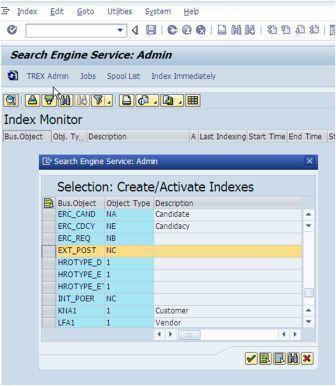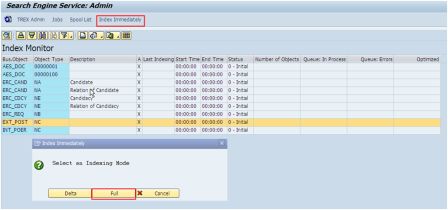
- SAP Community
- Products and Technology
- Human Capital Management
- HCM Blogs by Members
- SAP E-Recruiting new TREX configuration after upgr...
- Subscribe to RSS Feed
- Mark as New
- Mark as Read
- Bookmark
- Subscribe
- Printer Friendly Page
- Report Inappropriate Content
Applies to:
- SAP E-Recruiting Enhancement pack 4 Service Pack 7 onwards
- TREX Version 7.10.18.0 ( = TREX 7.1 with revision 18)
- Activated Business Function – HCM_ERC_CI_3
Introduction:
This document explains the new search functionality available in the SAP E-Recruiting module (Ehp4) subject to the system requirements stated above and all the necessary steps to upgrade the search functionality from older versions already using the SES search. If you are implementing SAP E-Recruiting fresh, please look for my other blog (coming soon). Clients used to ask me why SAP makes it so complex even to configure a simple functionality and I used to tell them that’s what you get when you buy packaged software. They have to think of several scenarios that their customers may use it. I should say they made it easier with Enhancement packages. But the downside is unless you had experience with all the enhancement packs particularly the changes that search had gone through, you may miss some important information hidden in the release notes. So I thought I will write a blog to explain this new feature available after you activate the enhancement switch.
Background:
In enhancement pack 3 using SES search, all the structured data ( infotypes) were indexed through SES and the unstructured data (attachments) were indexed through KPro. I have to tell that there were lots of issues in configuring the KPro indexes and to make the full text search on attachments work. Also you have to maintain the indexes separately apart from the ses indexes.
Current: (Ehp4 +)
Now the structured and unstructured data is no longer separated and hence the KPro index is obsolete. You don’t need to maintain the indexes in SKPR07. Also the performance of the search applications has increased greatly because of this comprehensive search. I haven’t done any benchmark study on this, just what I observed.
Steps:
1. Stop the periodical services background job. Go to transaction SM37 and using extended search, search for batch job with program name “RCF_PERIODICAL_SERVICES”. Then change the status of the batch job from released to scheduled via the menu path Job->Released to Scheduled
2. Deactivate KPRO Indexing. Go to transaction SPRO and uncheck the indexing for Document Area HR_KW. Please make sure you add this to the cutover plan as you have to perform this task in each environment ( Dev, QA, and Production)


3. Delete the entry “INDEX_DOCUMENTS” from the table via the IMG activity as shown below,


4. Delete all marked documents via the transaction SKPR07.


5. Change the logon procedure for the content server ICF service via the transaction SICF to “Logon Data Required”


6. Delete Indexes of existing SES Business Objects via transaction SES_ADMIN.

7. Restart the TREX server.
8. Create the indexes of SES business objects via transaction SES_ADMIN. Please make sure you log on to the system in English before you create indexes. Create the following indexes via the menu path Index->Create/Activate Indexes:


9. Execute the program RCF_SES_JOIN_INDEX_CREATE. Please make sure you logged in English before you execute this program.
10. Trigger full indexing of all SES business objects.


11. Delete the index category via transaction SRMO.

12. Clear all table entries related to KPRO indexes via transaction SKPR07.

If you get any errors, please delete all the inactive index categories manually.
13. Release the rcf_periodical_services batch job which was scheduled in step 1.
- SAP Managed Tags:
- SAP E-Recruiting,
- SAP ERP,
- HCM (Human Capital Management)
You must be a registered user to add a comment. If you've already registered, sign in. Otherwise, register and sign in.
-
1H 2024 Product Release
5 -
2H 2023 Product Release
1 -
ACCRUAL TRANSFER
1 -
Advanced Workflow
1 -
Anonymization
1 -
BTP
1 -
Business Rules
1 -
Canvas Report
1 -
Career Development
1 -
Certificate-Based Authentication
1 -
Cloud Platform Integration
1 -
Compensation
1 -
Compensation Information Management
1 -
Compensation Management
1 -
Compliance
2 -
Content
1 -
Conversational AI
2 -
Custom Data Collection
1 -
custom portlet
1 -
Data & Analytics
1 -
Data Integration
1 -
Dayforce
1 -
deep link
1 -
deeplink
1 -
Delimiting Pay Components
1 -
Deprecation
1 -
Employee Central
1 -
Employee Central Global Benefits
1 -
Employee Central Payroll
1 -
employee profile
1 -
Employee Rehires
1 -
external terminal
1 -
external time events
1 -
Generative AI
2 -
Getting Started
1 -
Global Benefits
1 -
Guidelines
1 -
H2 2023
1 -
HR
2 -
HR Data Management
1 -
HR Transformation
1 -
ilx
1 -
Incentive Management Setup (Configuration)
1 -
Integration Center
2 -
Integration Suite
1 -
internal mobility
1 -
Introduction
1 -
learning
3 -
LMS
2 -
LXP
1 -
Massively MDF attachments download
1 -
Mentoring
1 -
Metadata Framework
1 -
Middleware Solutions
1 -
OCN
1 -
OData APIs
1 -
ONB USA Compliance
1 -
Onboarding
2 -
Opportunity Marketplace
1 -
Pay Component Management
1 -
Platform
1 -
portlet
1 -
POSTMAN
1 -
Predictive AI
2 -
Recruiting
1 -
recurring payments
1 -
Role Based Permissions (RBP)
2 -
SAP CPI (Cloud Platform Integration)
1 -
SAP HCM (Human Capital Management)
2 -
SAP HR Solutions
2 -
SAP Integrations
1 -
SAP release
1 -
SAP successfactors
5 -
SAP SuccessFactors Customer Community
1 -
SAP SuccessFactors OData API
1 -
SAP Workzone
1 -
SAP-PAYROLL
1 -
skills
1 -
Skills Management
1 -
sso deeplink
1 -
Stories in People Analytics
3 -
Story Report
1 -
SuccessFactors
2 -
SuccessFactors Employee central home page customization.
1 -
SuccessFactors Onboarding
1 -
successfactors onboarding i9
1 -
Table Report
1 -
talent
1 -
Talent Intelligence Hub
2 -
talents
1 -
Tax
1 -
Tax Integration
1 -
Time Accounts
1 -
Workflows
1 -
XML Rules
1
- SAP SuccessFactors Employee Central: 1H 2024 Release Highlights in Human Capital Management Blogs by Members
- Automatic Hire in Human Capital Management Blogs by SAP
- Automatically populate the Region Description via User Connector in Human Capital Management Q&A
- Add to Transport Bundle in Employee Central in Human Capital Management Blogs by Members
- Introducing Exciting Innovations for System Administrators in Our New Software Release in Human Capital Management Blogs by SAP
| User | Count |
|---|---|
| 10 | |
| 6 | |
| 4 | |
| 4 | |
| 2 | |
| 2 | |
| 1 | |
| 1 | |
| 1 | |
| 1 |